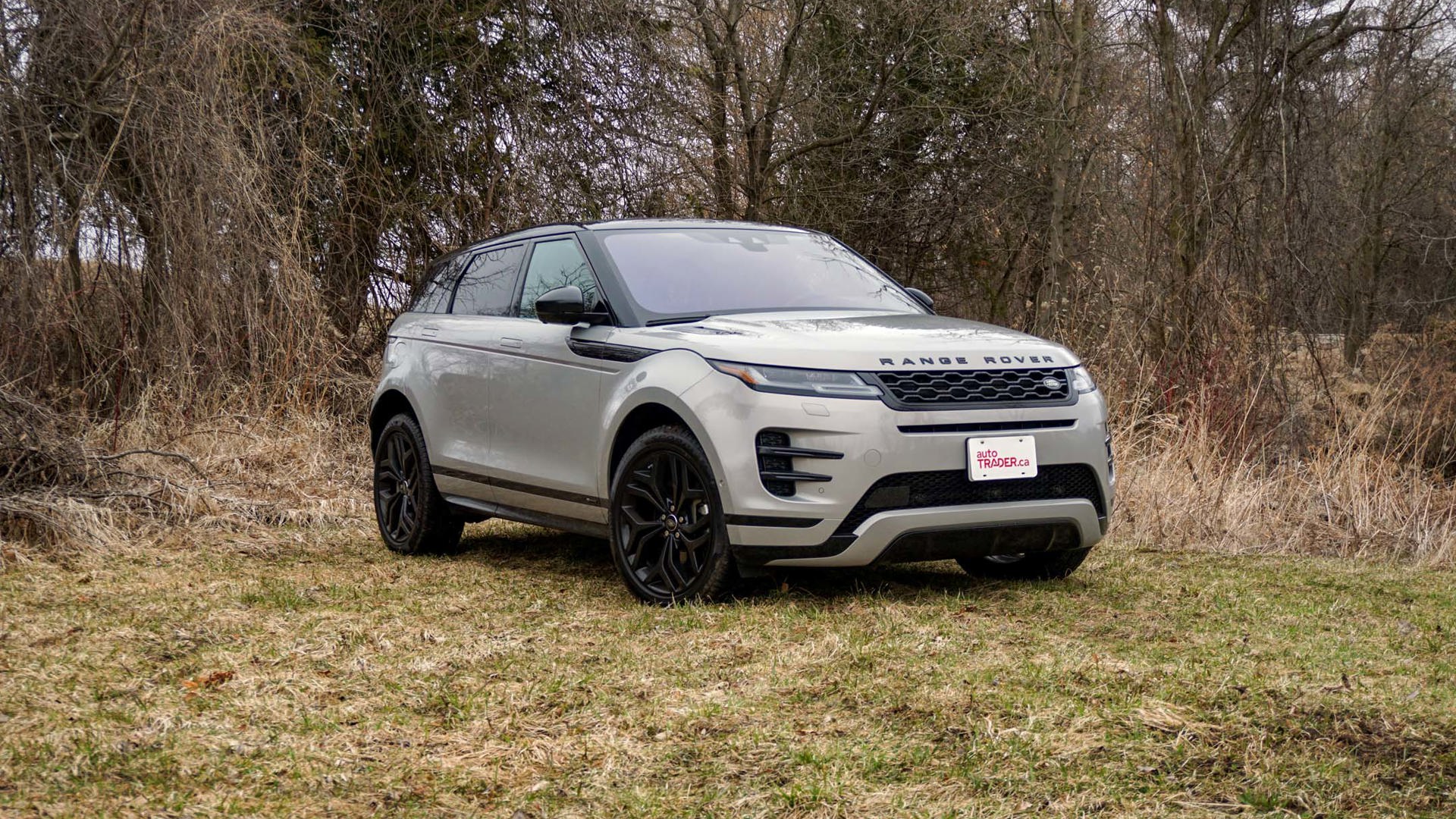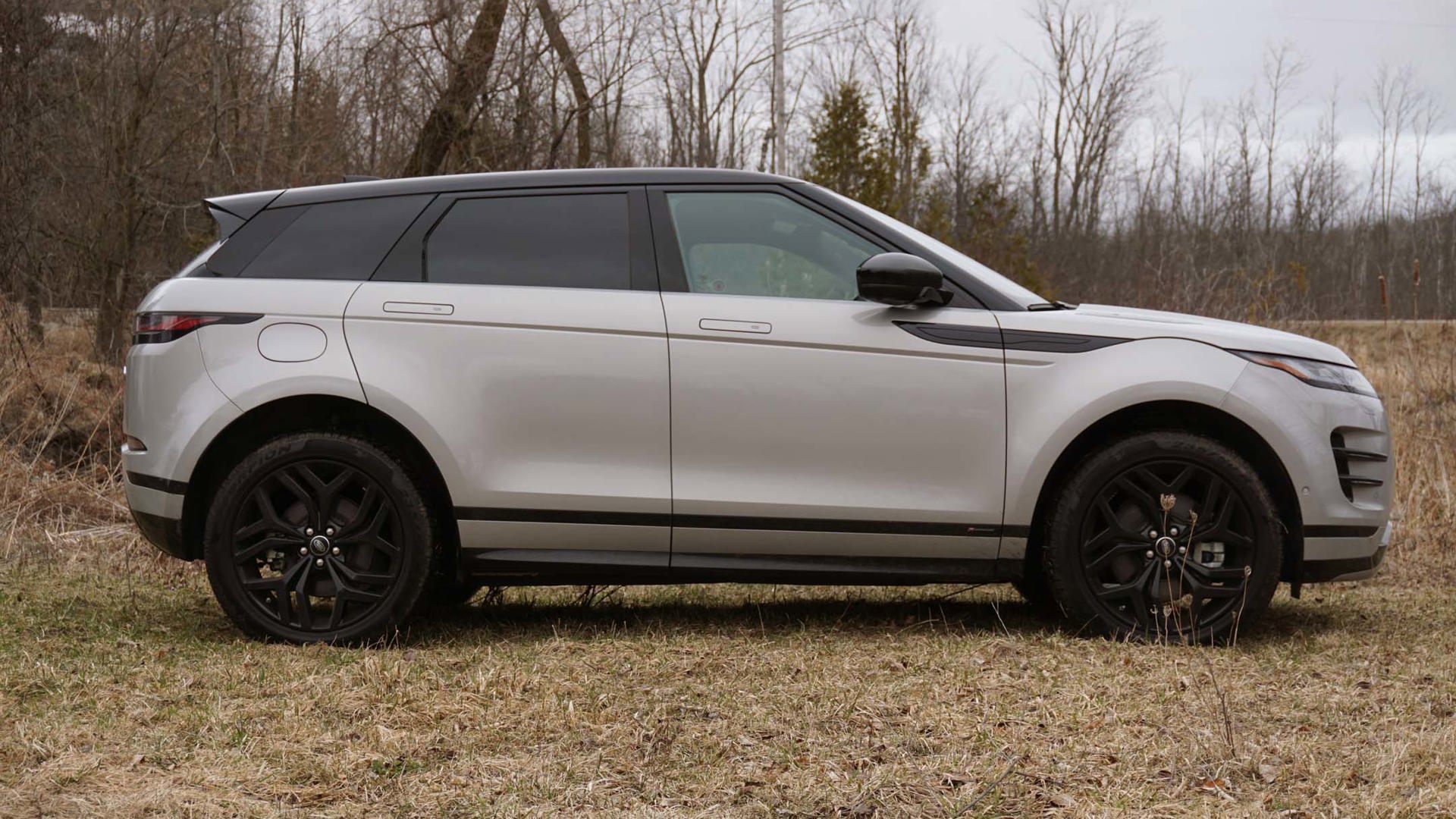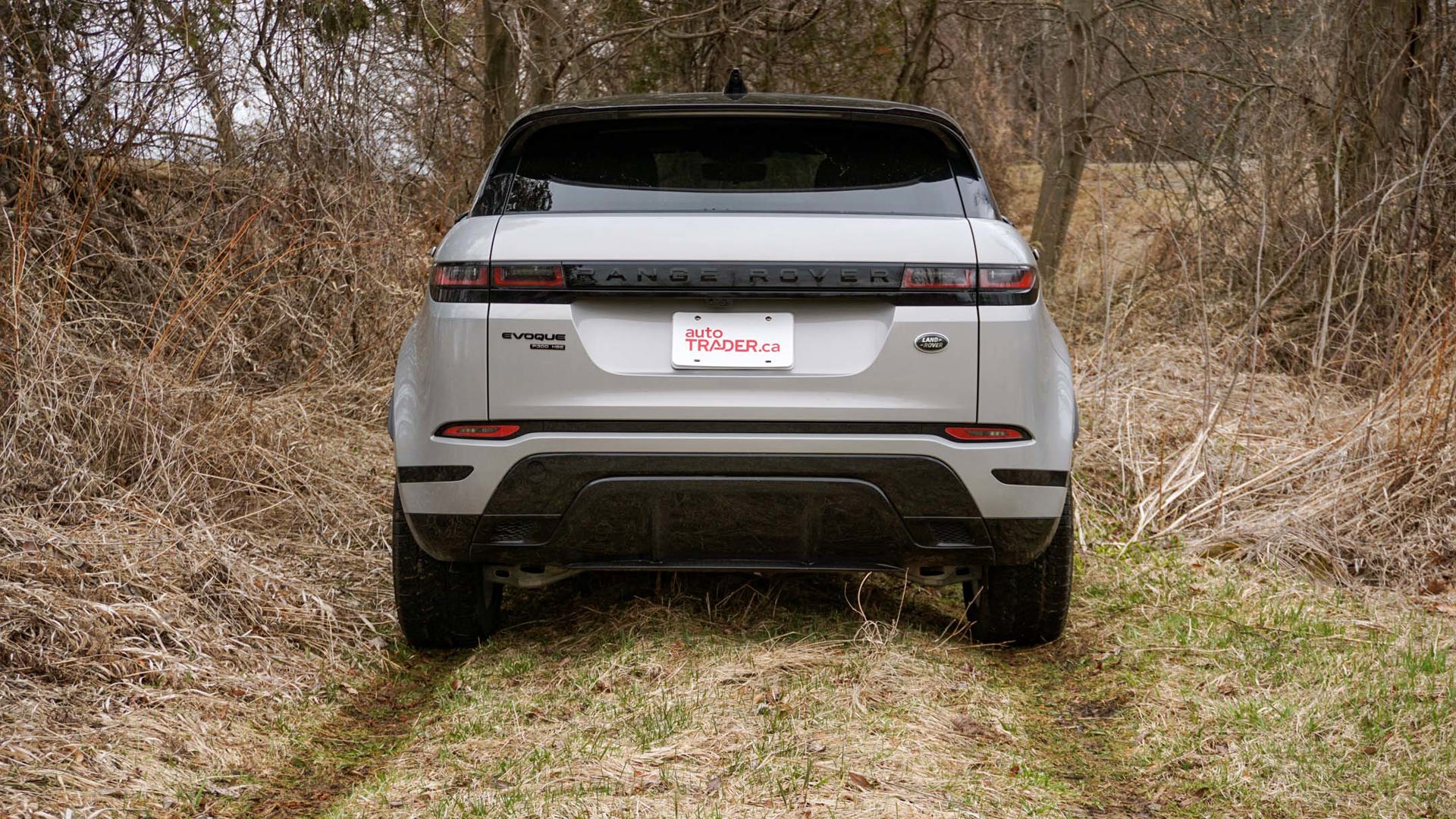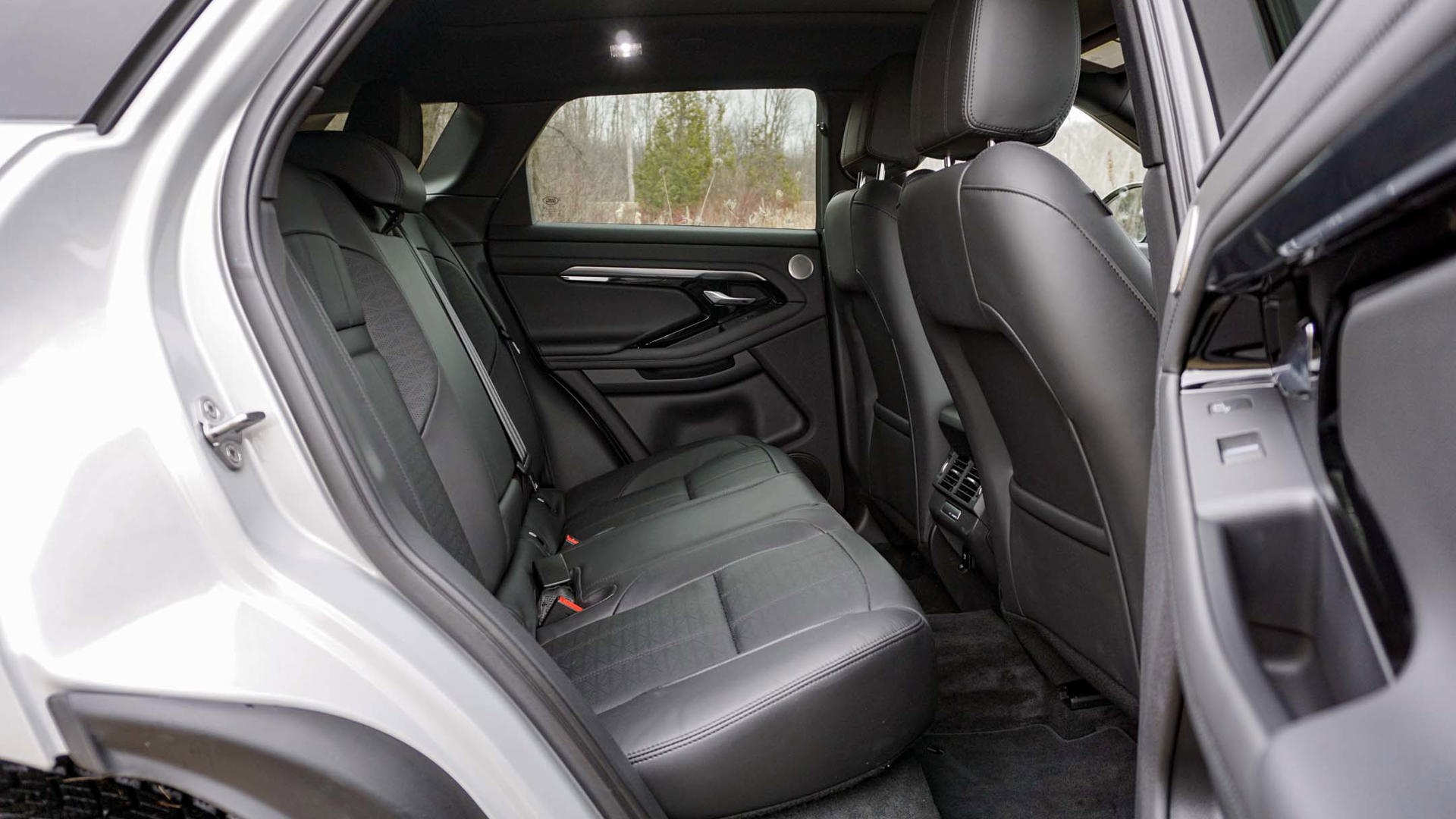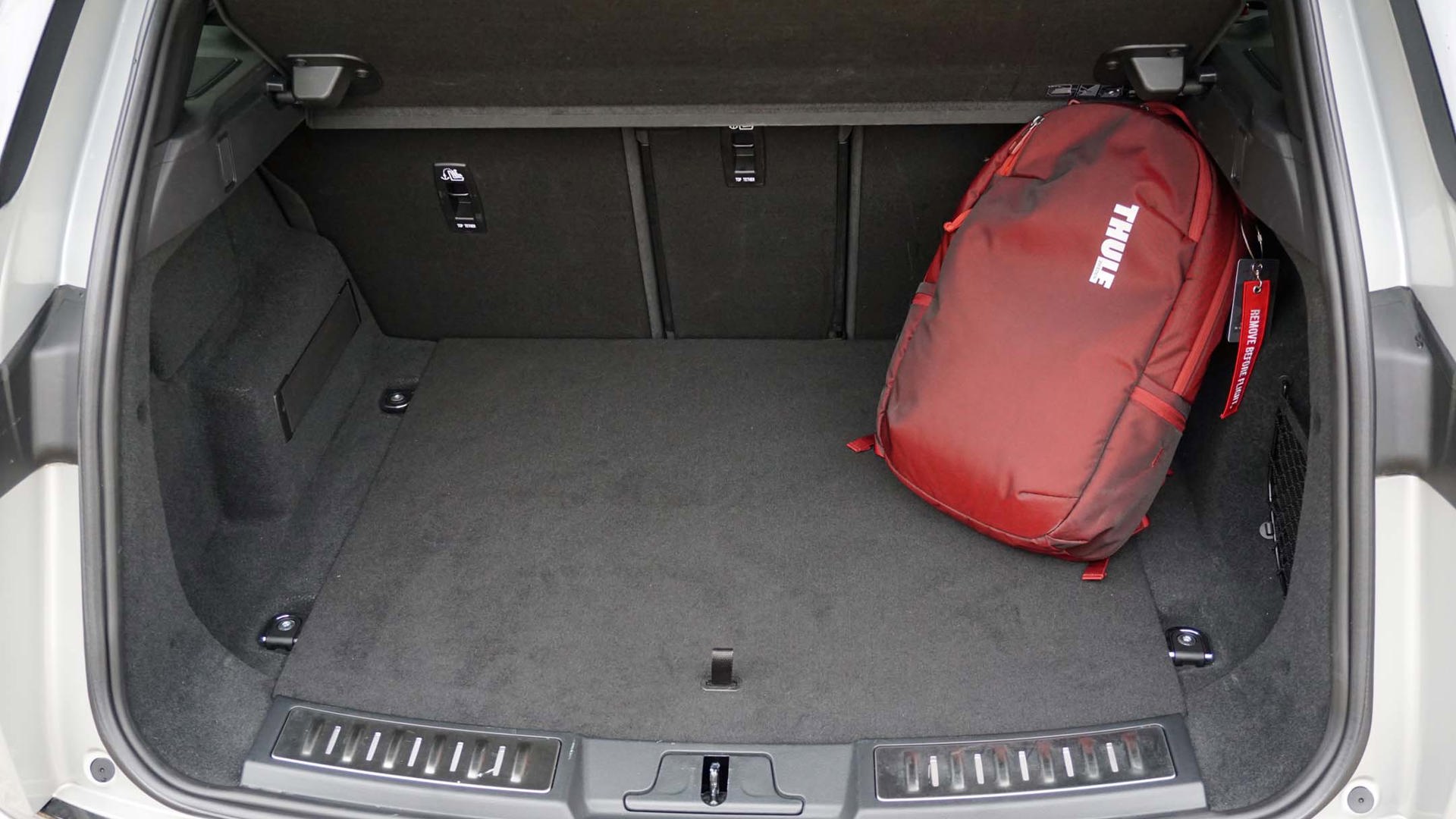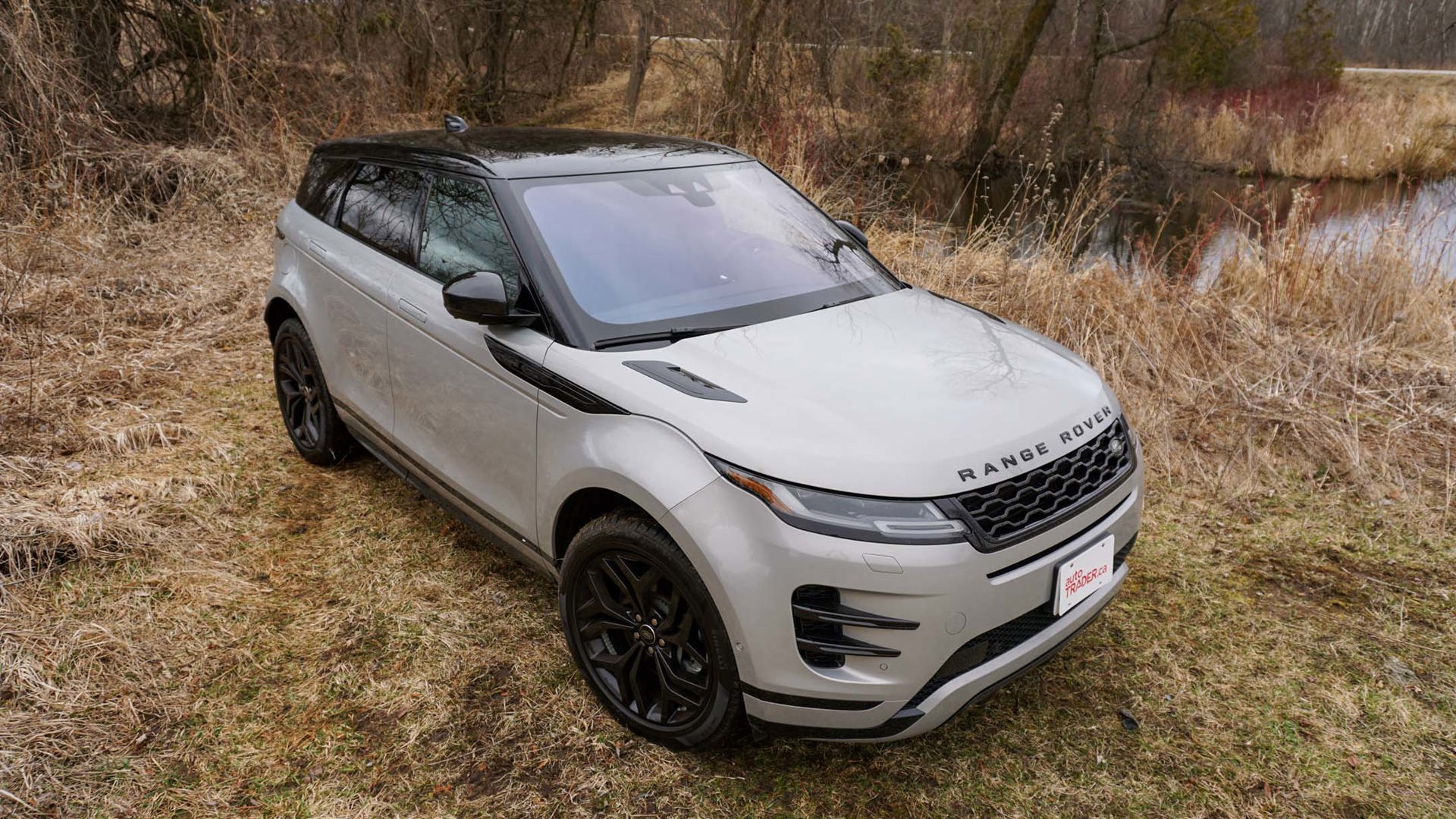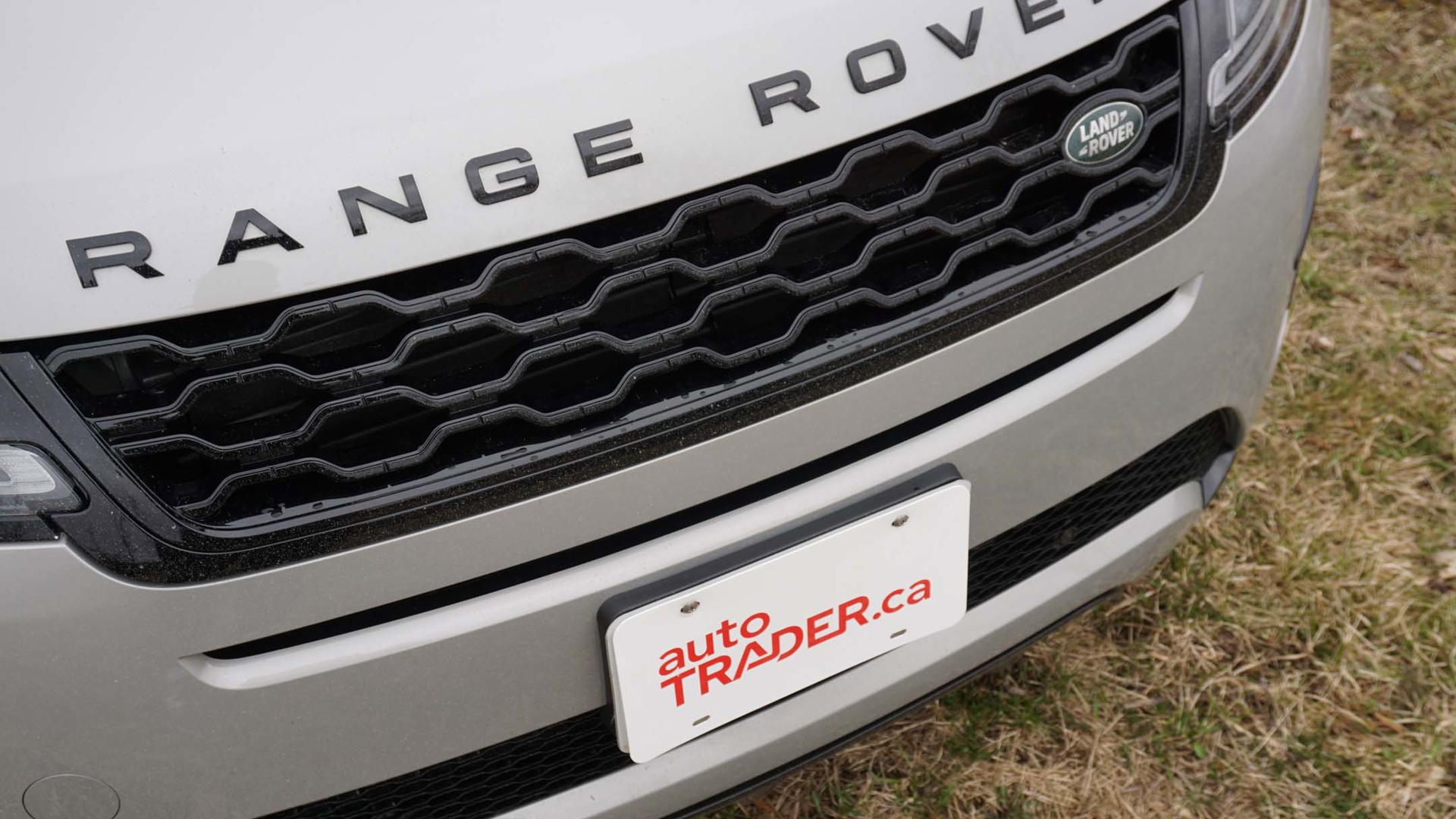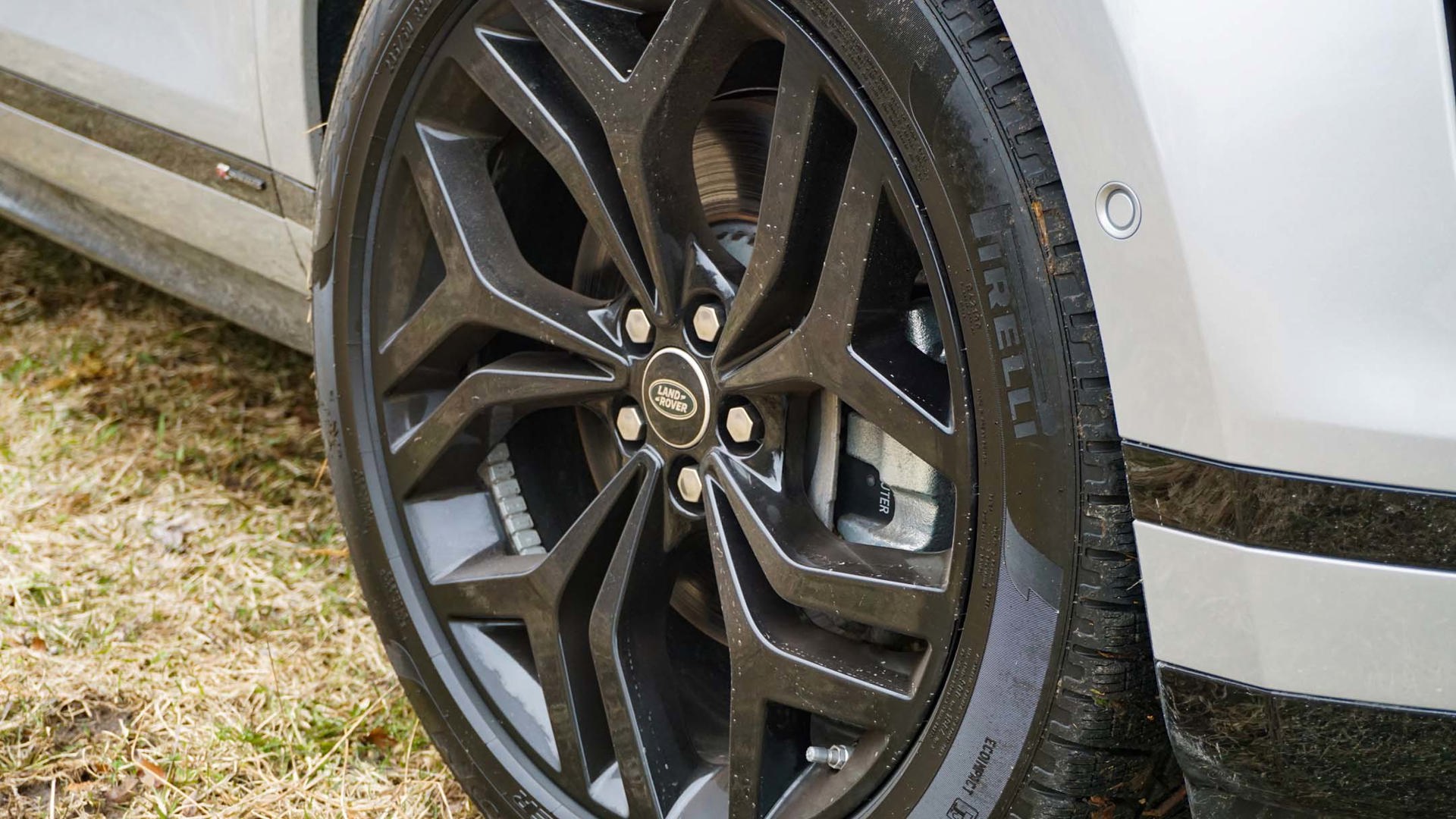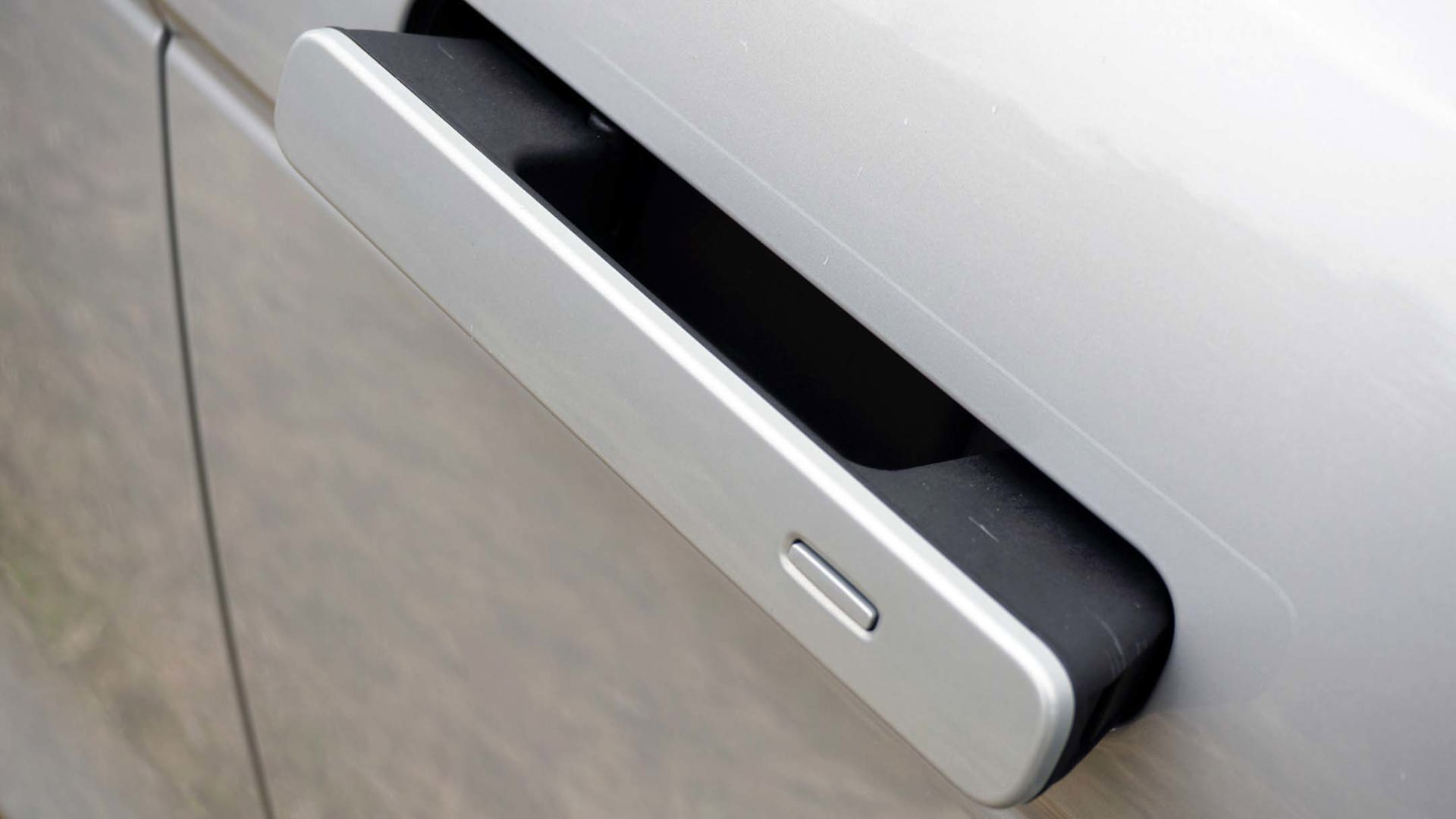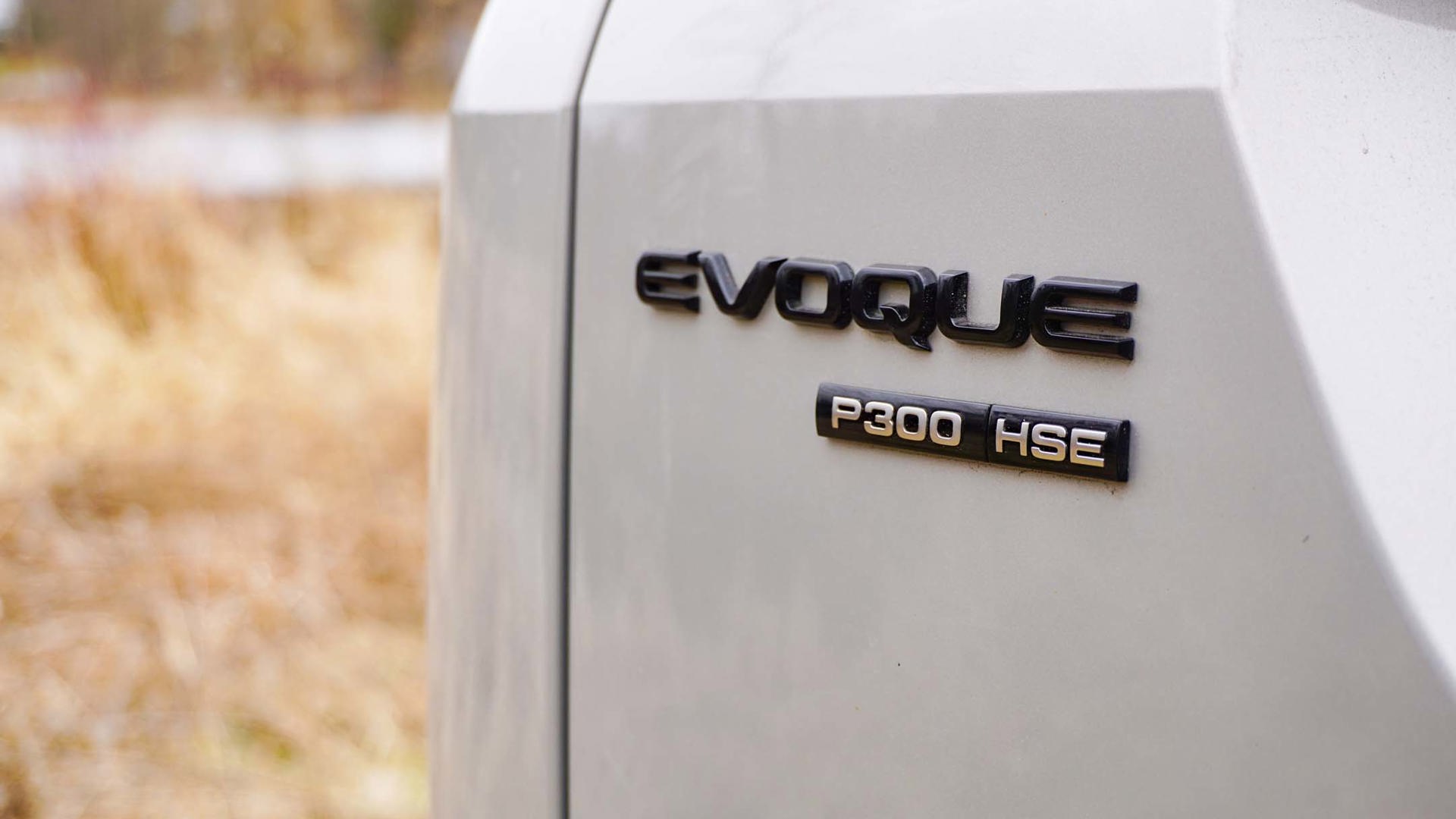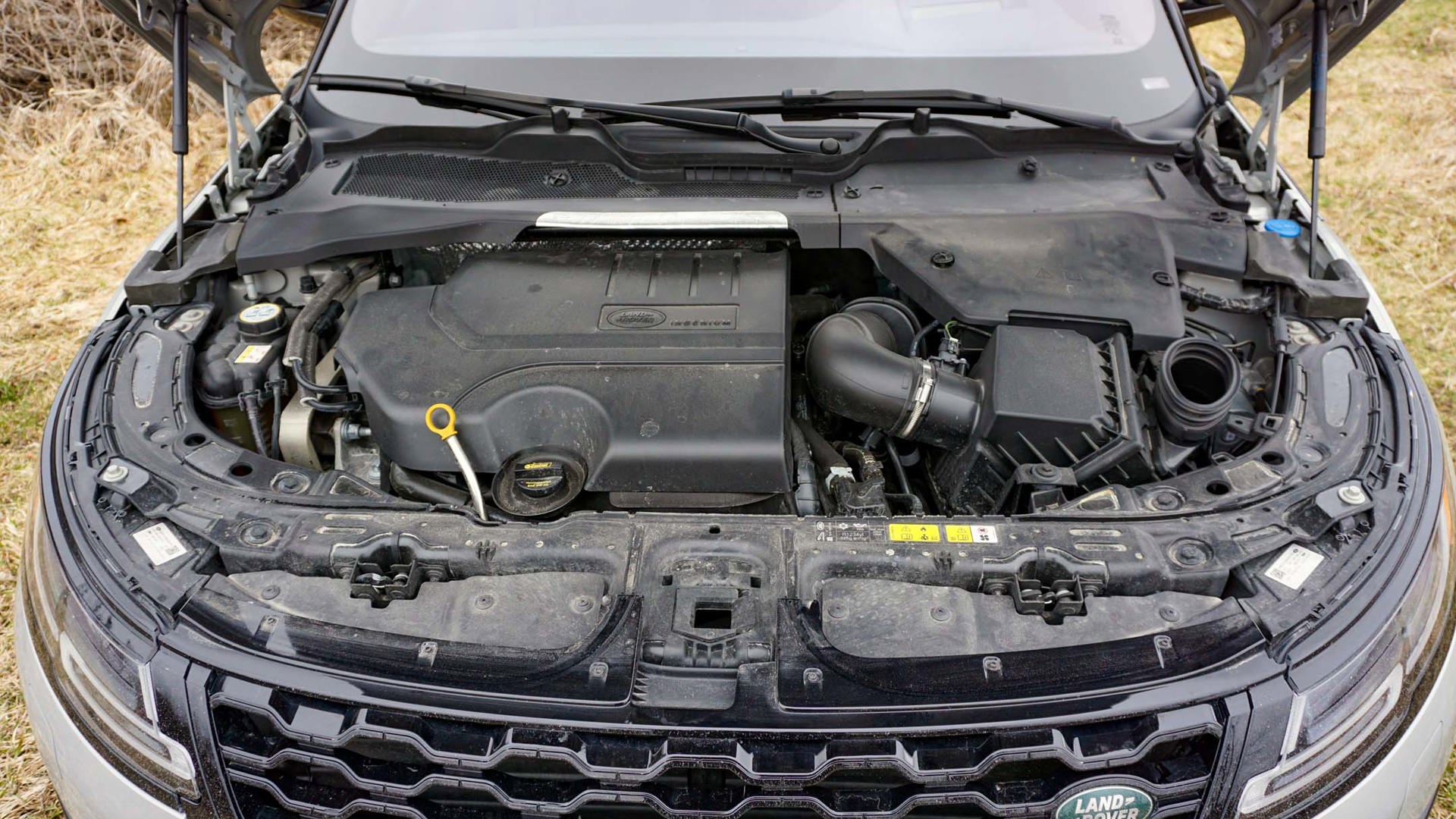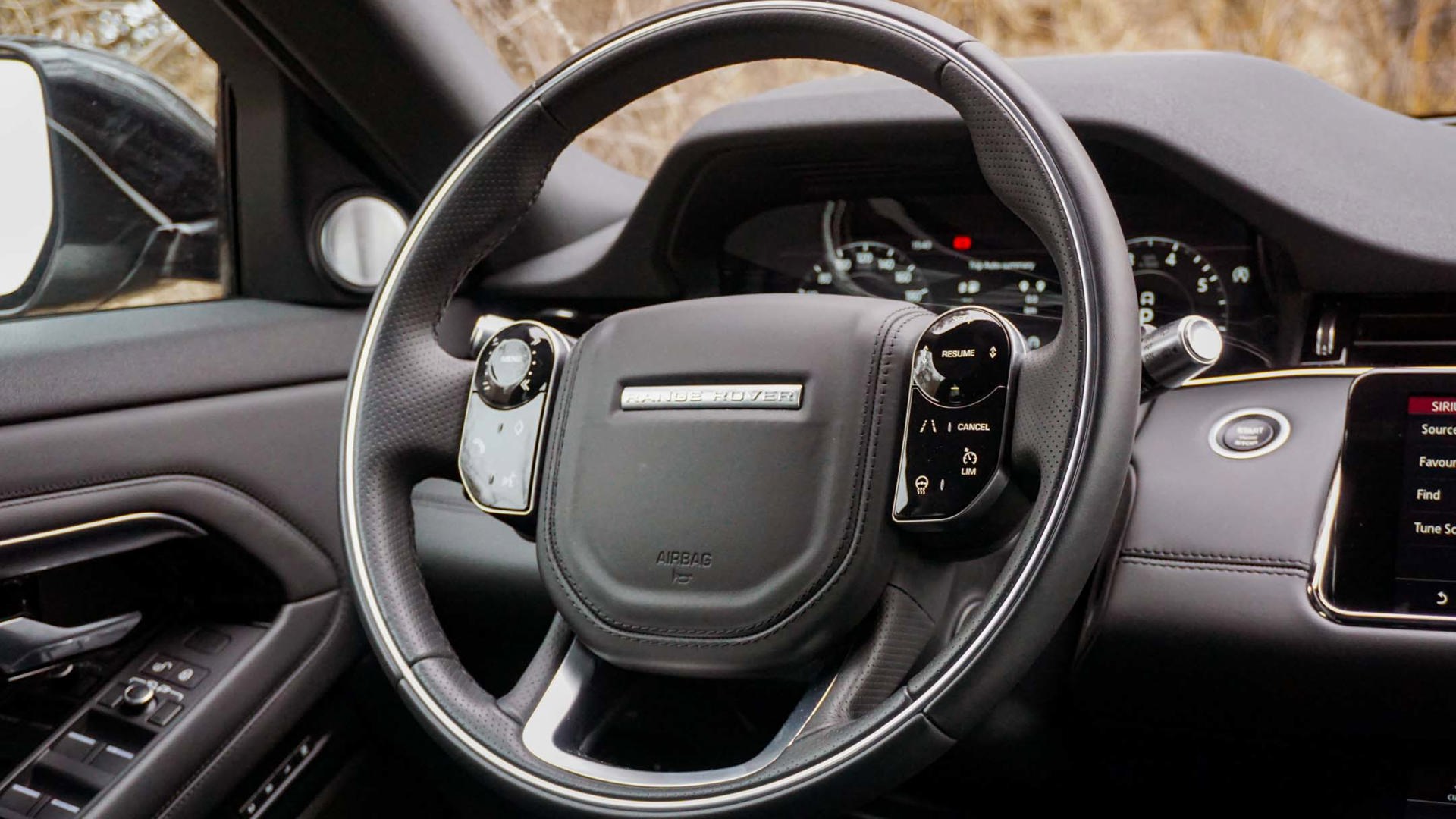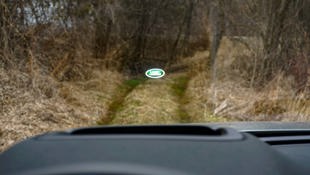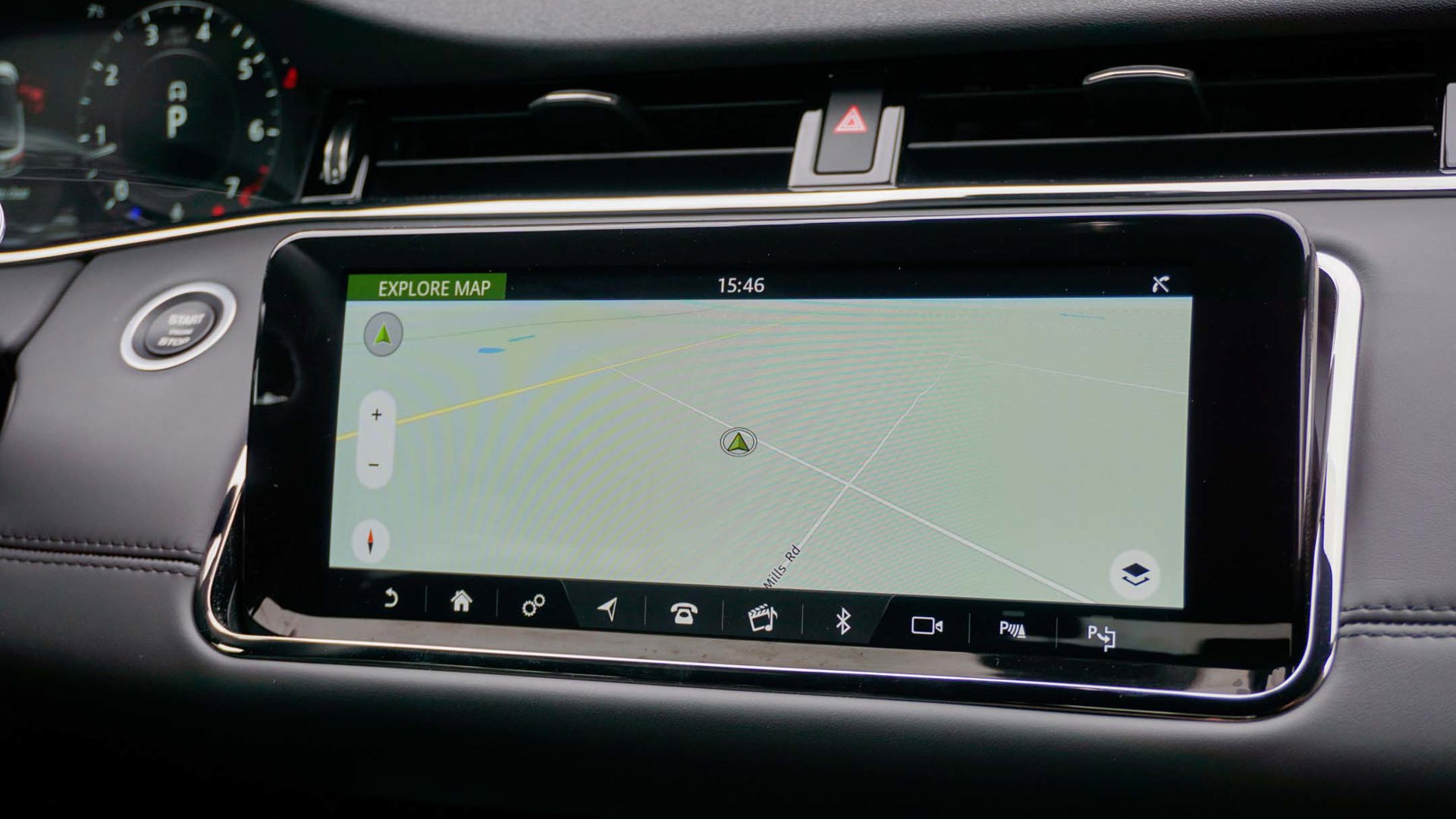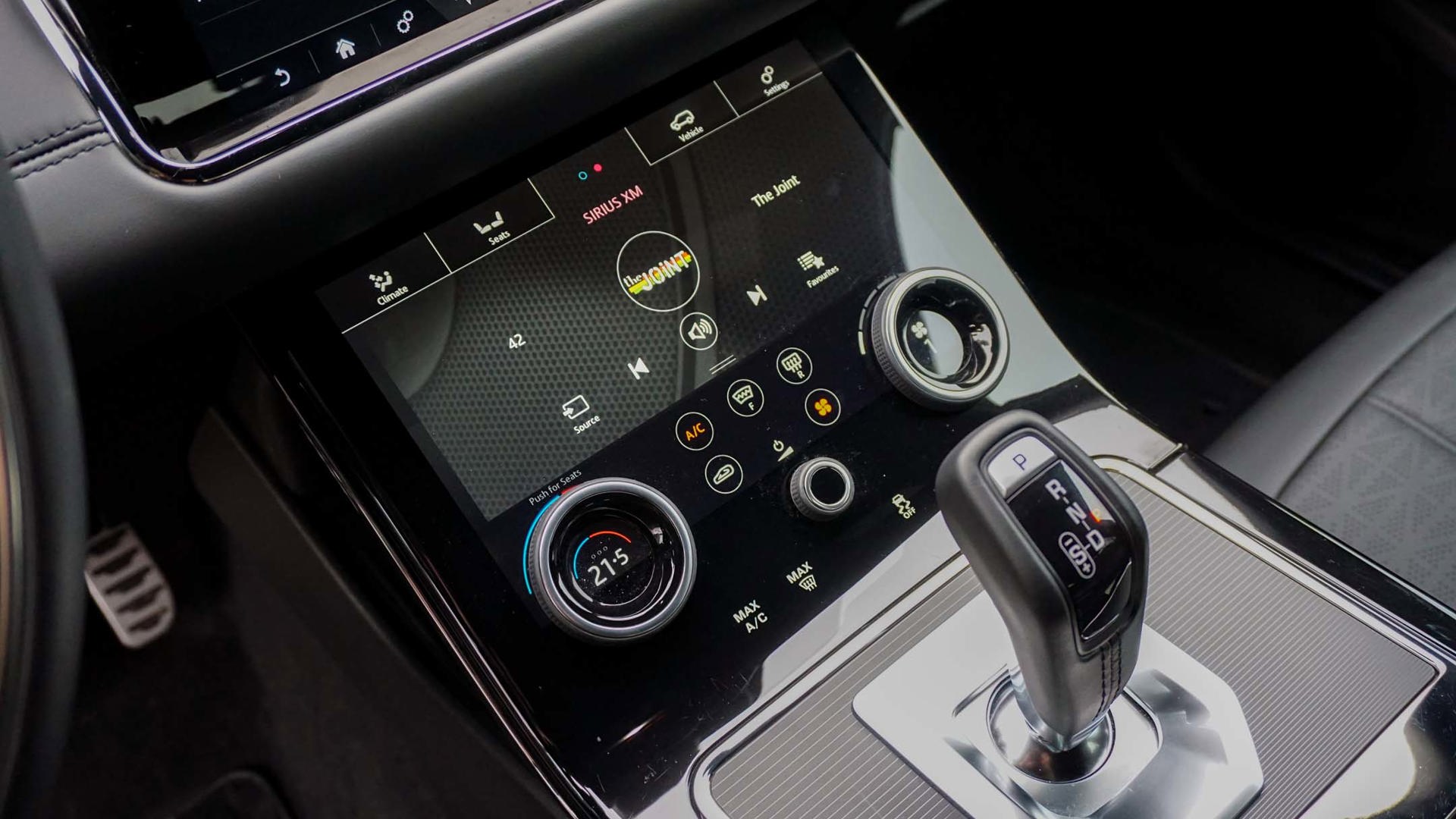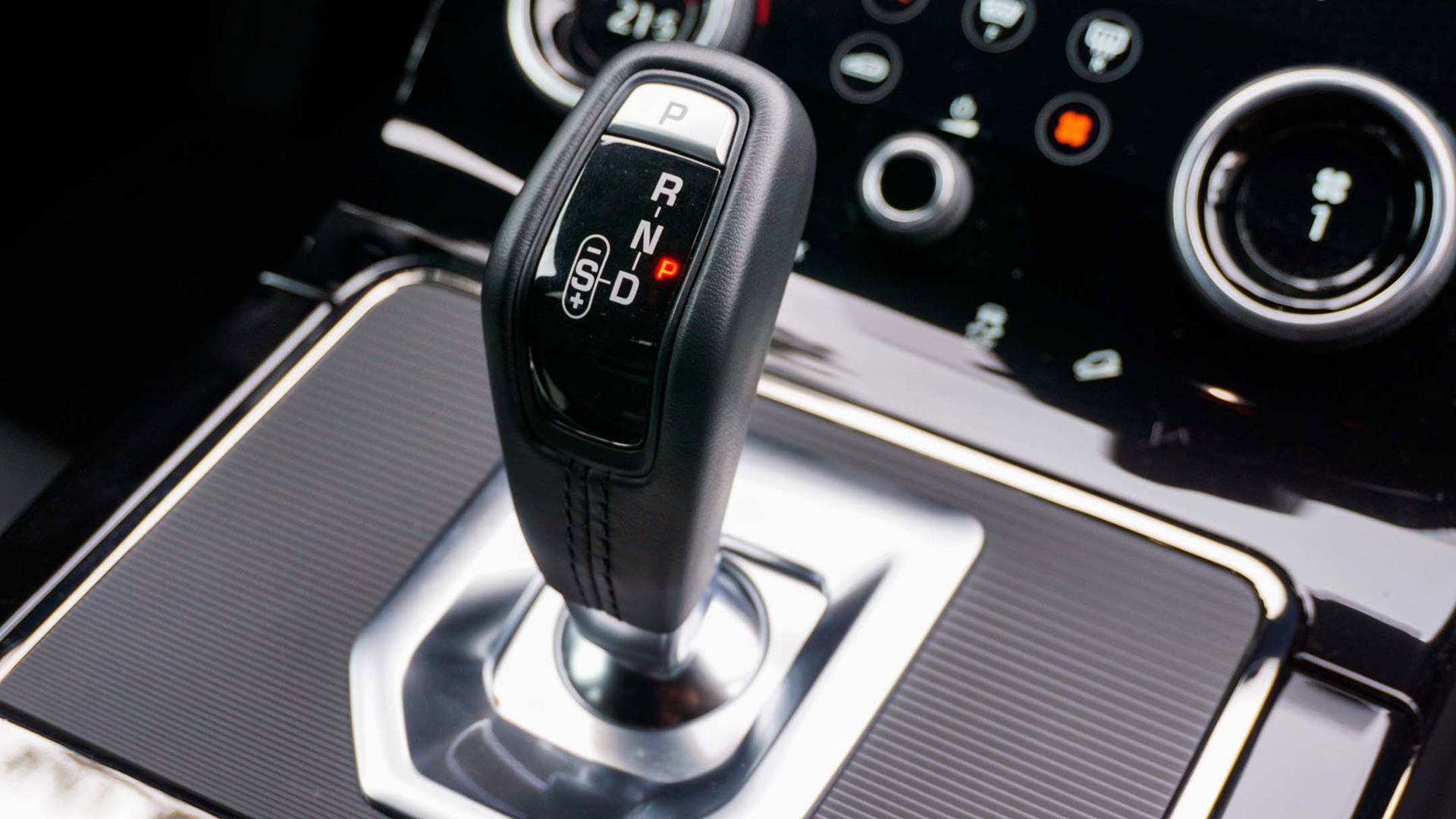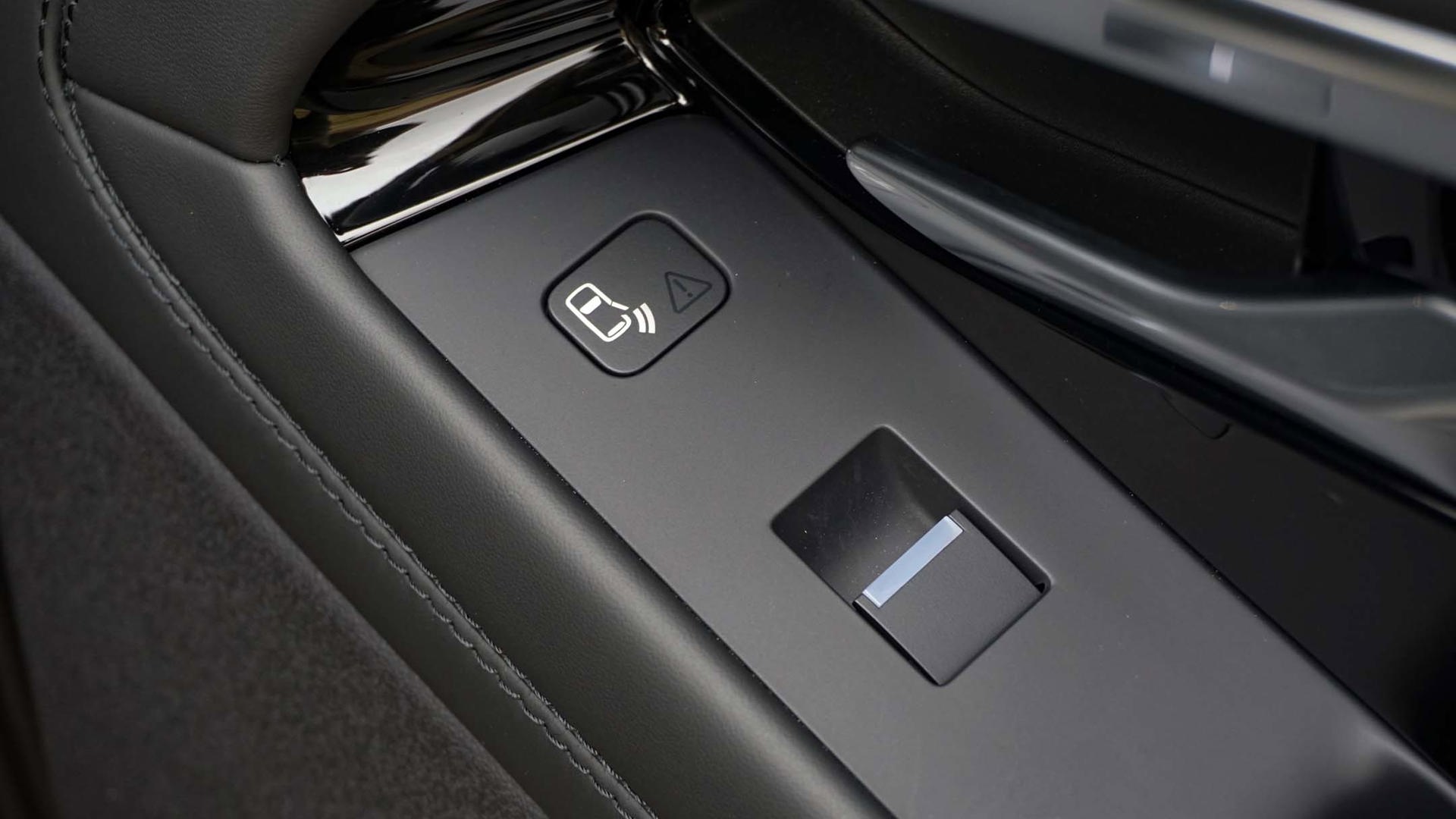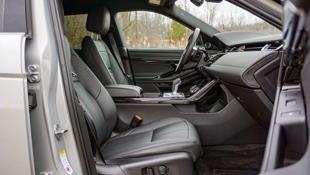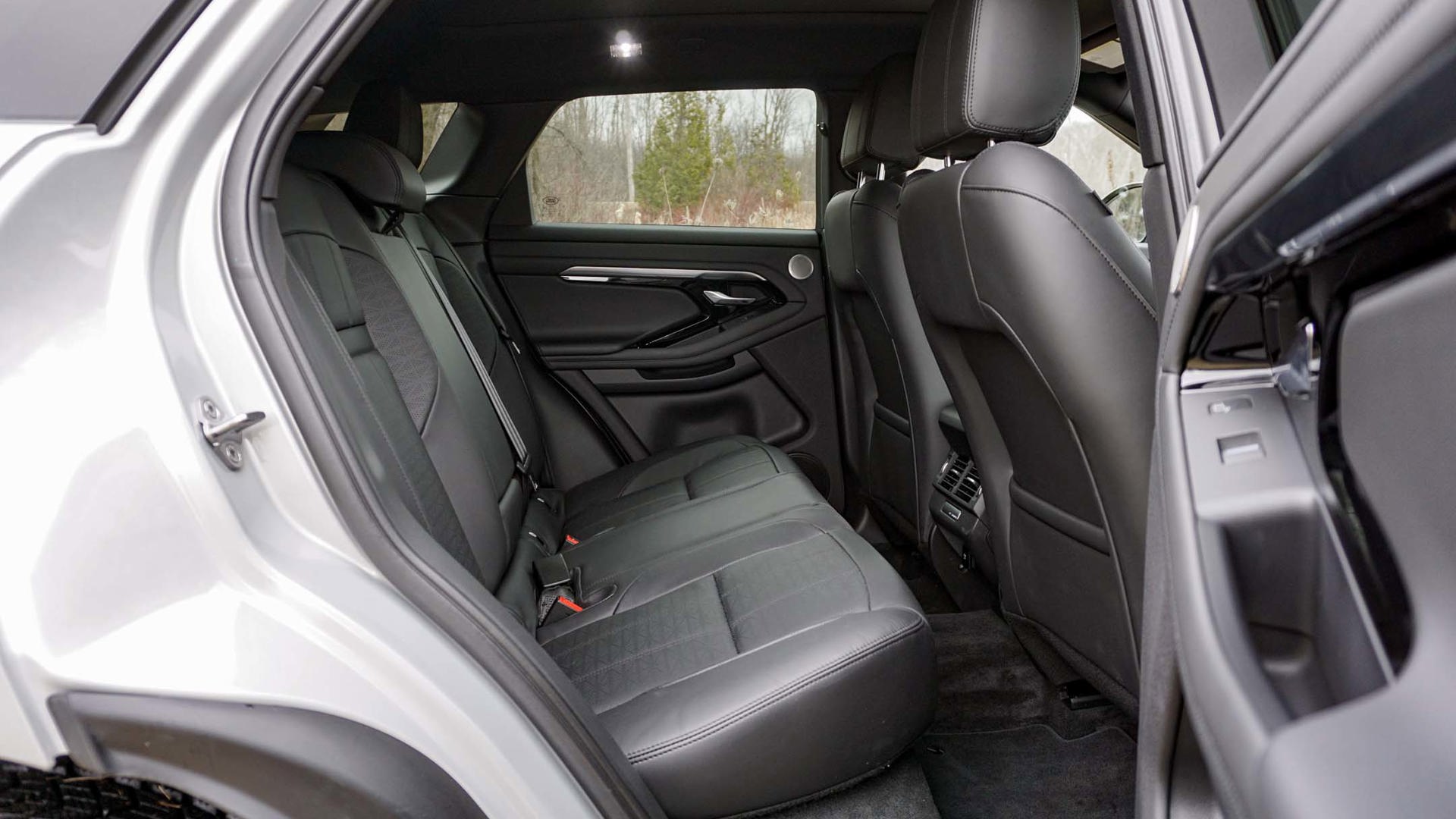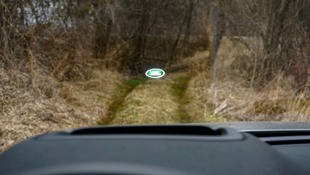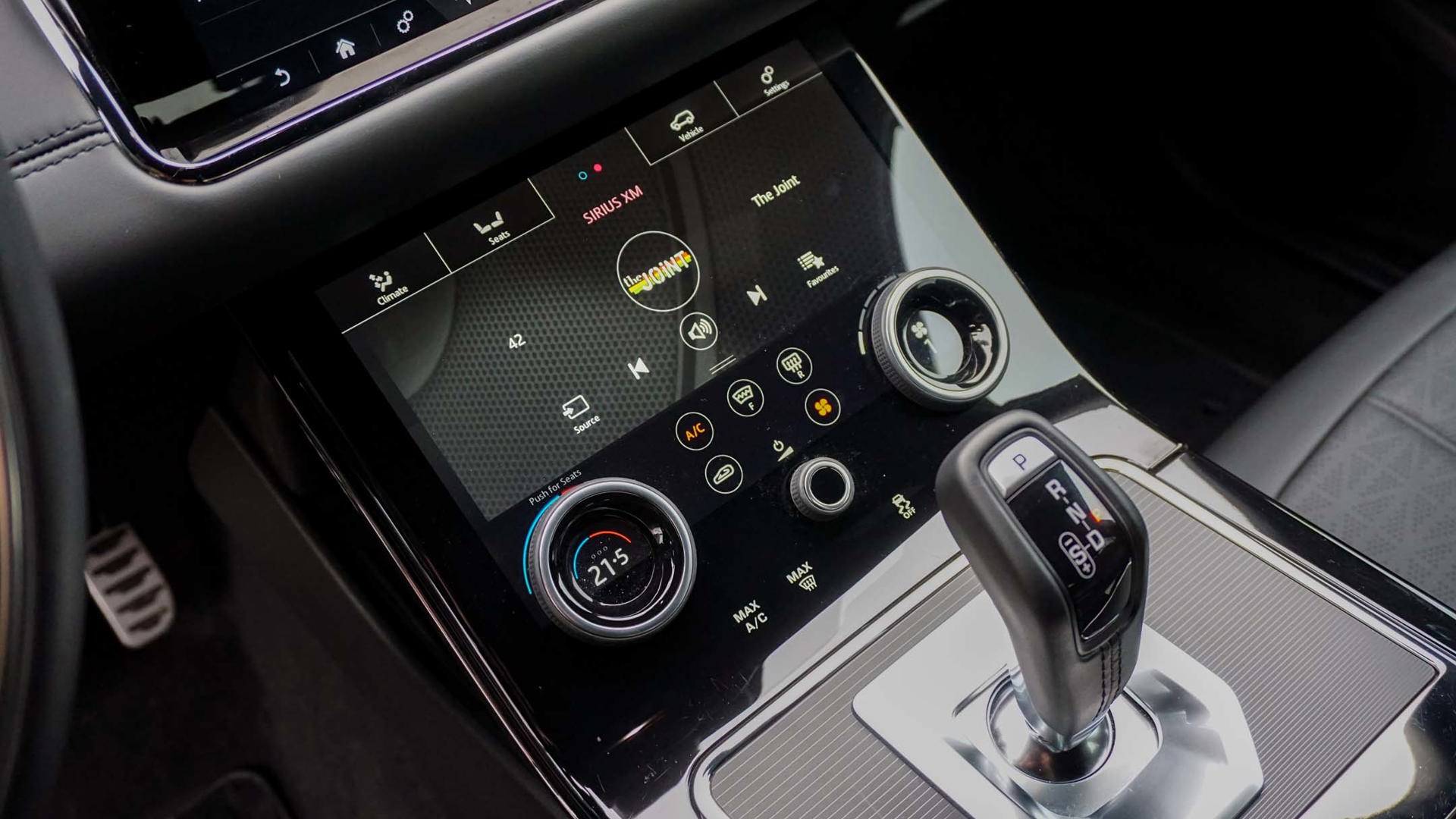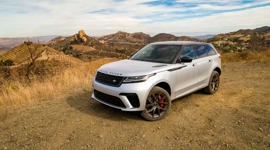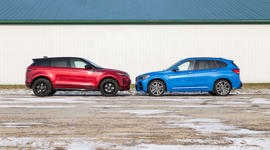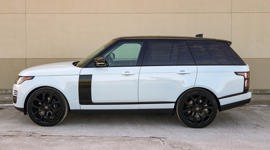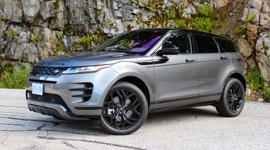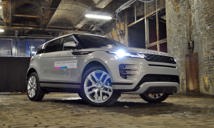 AutoTrader SCORE
AutoTrader SCORE
-
STYLING9/10
-
Safety9/10
-
PRACTICALITY8/10
-
USER-FRIENDLINESS8/10
-
FEATURES9/10
-
POWER8/10
-
COMFORT9/10
-
DRIVING FEEL9/10
-
FUEL ECONOMY6/10
-
VALUE7/10
Diminutive though its dimensions may be, the 2020 Land Rover Range Rover Evoque P300 R-Dynamic HSE sure manages to squeeze a lot inside of them.
Despite a serious dose of sticker shock – and an outlandishly long name – the top-of-the-line Evoque is a versatile little crossover that’s loaded with enough tech to make a Tesla owner green with envy.
Styling: 9/10
The Evoque was restyled last year, but it takes more than a passing glance to notice the differences from one generation to the next. The big clues are the retractable door handles that give the stylish little crossover a sleek look when they’re not deployed. Some copper-coloured accents adorn the exterior of R-Dynamic models, though an $800 package was added to the tester seen here to finish those and a number of other details in black, including the mirror caps and badging.
Interestingly, the black roof ($550) and wheels ($500) aren’t part of that blackout package, requiring checkmarks in separate option boxes. Combined with the fixed panoramic sunroof ($1,300) and upgraded silver paint ($800), the Evoque seen here leaves onlookers with a stylish impression, though it takes quite a few add-ons to do so.
The cabin is equally pleasing to the eye, even when finished in an understated black-on-black. (The perforated leather upholstery in the loaded HSE trim is also offered in grey, navy blue, and burgundy – all as no-charge selections.) Simple design lines lend themselves well to the modern look inside, as does the bevy of digital displays. While all versions of the Evoque feature a 10-inch touchscreen for infotainment duty, most add a second 10-inch touchscreen to control climate and other functions. Add in the 12.3-inch digital instrument cluster, digital rear-view mirror, and the optional head-up display, and there’s very little that isn’t displayed electronically in the Evoque.
Features: 9.5/10
Diving into the various displays inside reveals just how well-featured the littlest Land Rover is. However, even the priciest version has some head-scratching omissions from the list of what’s included, forcing prospective buyers to dive deep into the often-confounding options sheet.
Take the seats, for example: The top-of-the-line HSE – which apparently stands for High Specification Equipment – features 16-way power-adjustable front chairs that are heated. Adding heat to the rear seats is a $500 option, while another $300 includes ventilation functionality up front. However, for the same $800, it’s possible to subtract both of those features in favour of massaging front seats – or get all of the above for $1,600. Skipping the ventilation but adding the massage settings up front and heat in the back, meanwhile, will cost $1,300.
Then there are the features one might expect in this top trim that instead cost extra, like the $1,000 head-up display or the $1,100 steering assist feature for the adaptive cruise control system that helps keep the Evoque centred in its lane of travel. It’s all great stuff, though it really should be part of the package for the $62,500 MSRP the top trim carries – especially once the rest of what’s included is taken into account.
When it comes to comfort and convenience features, what separates the HSE from other trims is slightly subtle. There’s the digital rear-view mirror, an upgraded stereo, a hands-free power tailgate, keyless entry, and better-quality leather upholstery.
On the driver-assistance front, the top-of-the-line Evoque is loaded with all sorts of stuff ranging from lane-keep assist, automatic forward emergency braking, and traffic sign recognition (all of which is standard across the lineup) to blind-spot assist that helps prevent potential collisions via automated steering inputs, a self-parking system, and adaptive cruise control that works in stop-and-go traffic. The loaded version also gets an enhanced forward emergency braking system that works at speeds up to 160 km/h (the standard system works up to 80 km/h).
Safety: 9/10
While neither the Insurance Institute for Highway Safety (IIHS) nor the National Highway Traffic Safety Administration (NHTSA) have conducted testing on the Evoque, the European New Car Assessment Programme (Euro NCAP) awarded the subcompact crossover its five-star safety rating. Particularly high scores were awarded for adult and child occupant protection, while the Evoque only earned a marginal rating for its automatic emergency braking system’s ability to detect cyclists. Euro NCAP testing did, however, report good functionality of the auto-braking system at highway speeds when approaching a slower moving or braking vehicle ahead.
User Friendliness: 8.5/10
With very few physical controls to work with, there is a slight learning curve when it comes to the Evoque’s dual touchscreen setup. It doesn’t take long to adjust to the centralized system, though the responsiveness of the lower screen, in particular, is painfully slow. That means toggling between the various menu items it controls – HVAC controls, for example, or those optional massaging seats – requires some additional patience.
The faults are few with the dual-screen setup, though, and the pros outweigh the cons. For starters, the widescreen format of the 10-inch upper display isn’t just aesthetically pleasing but provides a generous map view that comes in handy when navigating unfamiliar areas. The lower display also acts as a supplementary entertainment hub, which means there’s no need to choose which function takes precedence. This also has its benefits for Apple CarPlay and Android Auto users, with audio apps like Apple Music displaying on the lower screen (including album art) while maps, phone, or messaging interfaces appear simultaneously on the screen up top.
Power: 8.5/10
No vehicle in the Jaguar Land Rover portfolio is more worthy of the automaker’s mild hybrid technology than its smallest sport utility. (The same goes for the Evoque’s fraternal twin, the Jaguar E-Pace.) The electrical portion of the powertrain generates energy during braking and stores it for use when accelerating – a nifty trick that makes the Evoque feel faster than its zero-to-100 km/h sprint time of 6.6 seconds would suggest.
Working in tandem with that kinetic energy system is a turbocharged 2.0L four-cylinder gas engine – the pair have a combined system output of 296 hp and 295 lb-ft of torque – and a nine-speed automatic transmission, which routes power to all four wheels.
The powertrain prefers smooth throttle inputs when accelerating, responding well to progressive pedal play when scooting off the line. That’s also when the jolt of electricity from the hybrid system is most noticeable, the extra surge of momentum kicking in at just the right time to mask much of the gas engine’s turbo lag.
Fuel Economy: 6/10
The Evoque R-Dynamic may not be capable of running on electrons alone despite its mild hybrid system, though its tiny turbo engine and small stature should be enough to make this a miserly runabout. And, indeed, fuel consumption figures from Natural Resources Canada (NRCan) suggest that’s the case. With ratings of 11.4 L/100 km in the city and 8.9 L/100 km on the highway – and a combined 10.3 L/100 km – the Evoque isn’t the most efficient crossover of its kind, but it’s about average for the segment.
Unfortunately, real-world consumption was far worse, with the Evoque sucking back premium-grade gasoline to the tune of 13.2 L/100 km over the course of a week’s worth of testing. That much of the roughly 400 km was spent cruising country roads at a relaxed pace makes for a disappointment at the pumps. Granted, the Evoque features all-wheel drive and the version tested was sporting 20-inch wheels shod in winter rubber. However, that’s a steep decline in efficiency to blame on up-sized alloys, winter tires, and an all-wheel-drive system that disconnects the rear wheels until extra traction is needed.
Driving Feel: 9/10
The on-road demeanour of the Evoque is certainly a unique one. Despite its small stature – at 4,371 mm long, it’s 148 mm shorter than a Honda Civic hatchback – it cruises around like a much larger luxury vehicle. It’s also a Land Rover, which means it can hold its own off the beaten path. Yet the Evoque also boasts an agility that isn’t hindered by the fact it can wade through water up to the tops of its wheels.
No, it’s not sporty the way the BMW X2 M35i is, but the Evoque still manages to deliver an engaging drive should the mood strike. Despite its generous 212-mm ground clearance, it drives like a sporty hatchback when pushed, with minimal body roll even through the sharpest of switchbacks. Credit a wheelbase that pushes the wheels to the corners, improving responsiveness while also giving the Evoque decent approach and departure angles that come in handy off-road.
Shifts from the transmission are crisp and precise, while the engine braking that’s engaged via the steering-wheel-mounted paddle shifters breathes a second life into the peppy powertrain – one of a playful and downright dynamic nature. While there’s no selectable sport mode, the suspension is well-tuned for spirited driving even without the available adaptive dampers.
Whether the Evoque is being pushed hard or piloted gently, the steering setup is superb. Adequately direct and appropriately heavy, keeping the Evoque moving in its intended direction of travel isn’t a chore.
Practicality: 8.5/10
The Evoque is the smallest vehicle in the Land Rover lineup, but it doesn’t necessarily feel that way inside. The cabin is somewhat narrow, but it can accommodate four adults with ease. Even with the front seats positioned for long-limbed occupants, legroom in the second row is surprisingly spacious.
The rear seats feature 40/20/40 split-folding functionality, allowing longer items to fit while still offering space for four occupants – an unfortunately uncommon feature that pays dividends here. While the seats themselves don’t fold completely flat, the 1,156 L of total cargo room is more than adequate when extra space for stuff is needed.
Behind the back seats, the Evoque’s 472 L is less than most competitors by the numbers, but they don’t tell the whole story. A deep and wide area allows cargo of all shapes and sizes to fit behind the tailgate, while tie-downs allow items to be secured in the back if required.
For those brave enough to venture off-road in the Evoque, generous ground clearance and variety of electronic aids ensure it’s up to the challenge. There are a handful of settings for different terrains – mud, sand, rocks, and the like – that are accessed through the lower infotainment screen, tailoring the drivetrain to perform at its best in those conditions.
Comfort: 9.5/10
The level of opulence the Evoque provides is truly befitting of the Range Rover name. While most premium brands’ entry-level models are exactly that – entry-level – the Evoque is an upscale ride that’s unlike anything else its size. With a well-damped suspension that’s suited to even the roughest roads, it was only this tester’s 20-inch wheels that made the presence of ruts and washboards known. Likewise, the level of sound insulation is second to none, with little from the outside world making its way into the cabin.
And then there are the seats. Thick and firmly padded, they provide users with plenty of support on longer drives without much fatigue or discomfort. The optional massaging from seats found in the tester shown were also a nice touch, though the actuators that run the various settings were quite noisy – and the massage programs themselves only lasted a short time before automatically shutting off.
Value: 7/10
The Evoque certainly occupies a unique space in the premium subcompact crossover segment, and it has the pricing model to match. While it does offer upscale opulence that outclasses the competition, its starting price of $47,500 before freight and fees registers well above its rivals – and it only goes up from there.
Those who want the added jolt of the mild hybrid system will pay $53,500 before freight and fees for the cheapest R-Dynamic model, while the top R-Dynamic HSE tester seen here starts at $62,500. With some $9,700 in options, however, this example carried a pre-tax price of $74,000 – a substantial sum of money for something so small.
Considering all that’s including in the slightly larger – and far sleeker – Range Rover Velar, there’s a compelling case to be made for the version with the same engine found here, which starts at $68,500. Even a Mercedes-Benz C-Class wagon with all the options added rings it at less, and it offers more room in the process.
The Verdict
With great little crossovers like this from brands like Audi, BMW, and Mercedes, the Evoque might not be the first one that comes to mind – but maybe it should be. Those looking for prestige in a small package will certainly find it here, though it doesn’t come cheap. Looking past the price, however, few crossovers deliver the type of technology, versatility, and comfort the loaded Evoque does at this size and beyond.
| Engine Displacement | 2.0L |
|---|---|
| Engine Cylinders | Turbo I4 MHEV |
| Peak Horsepower | 296 hp @ 5,500 rpm |
| Peak Torque | 295 lb-ft @ 1,500–4,500 rpm |
| Fuel Economy | 11.4/8.9/10.3 L/100 km cty/hwy/cmb |
| Cargo Space | 472 / 1,156 L seats down |
| Model Tested | 2020 Land Rover Range Rover Evoque P300 R-Dynamic HSE |
| Base Price | $62,500 |
| A/C Tax | $100 |
| Destination Fee | $1,700 |
| Price as Tested | $74,000 |
|
Optional Equipment
$9,700 – Massaging Seats, $1,300; Fixed Panoramic Roof, $1,300; Head-Up Display, $1,000; Seoul Silver Pearl Paint, $800; Surround-View Camera, $800; Black Pack, $670; Cold Climate Pack, $670; Meridian Surround Sound, $600; Black Contrast Roof, $550; Power-Adjustable Steering Column, $510; Black 20-inch Wheels, $500; Satellite Radio, $500; Illuminated Front Sill Plates, $300; Headlight Washers, $200
|
|
